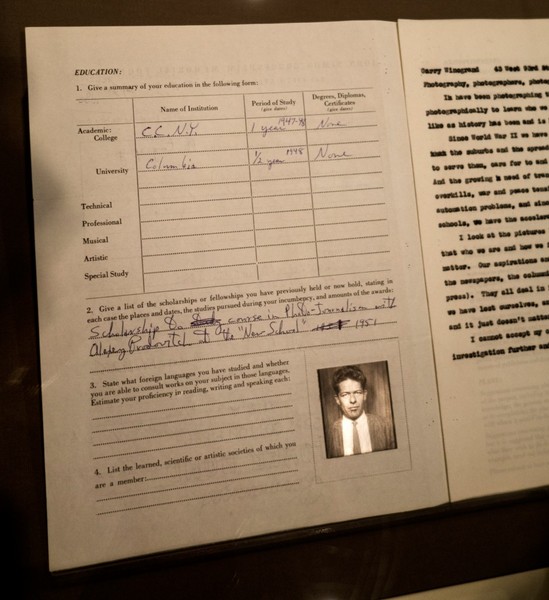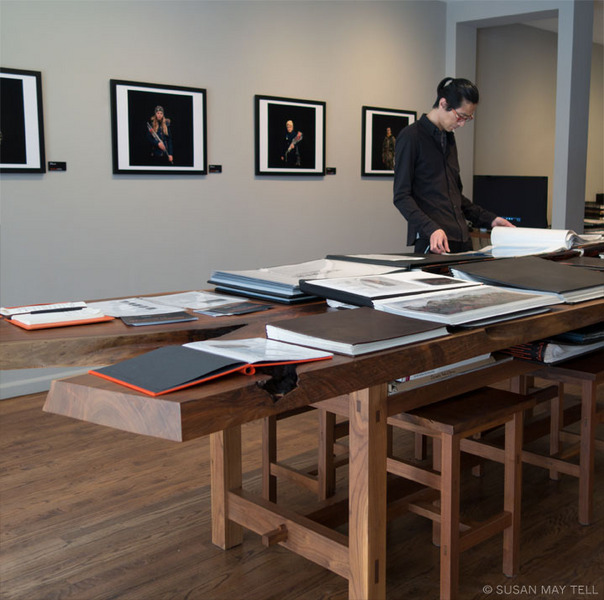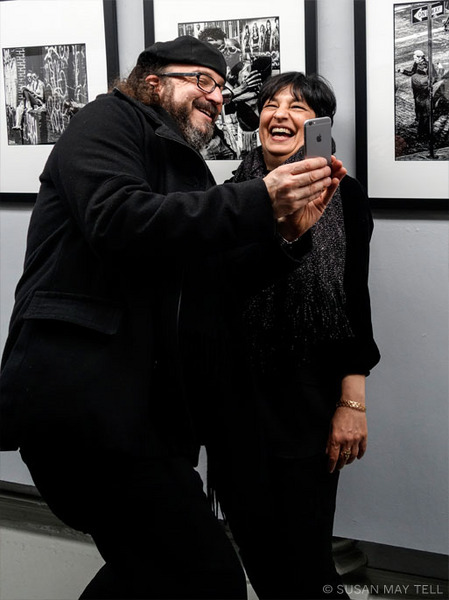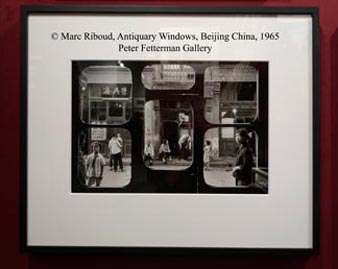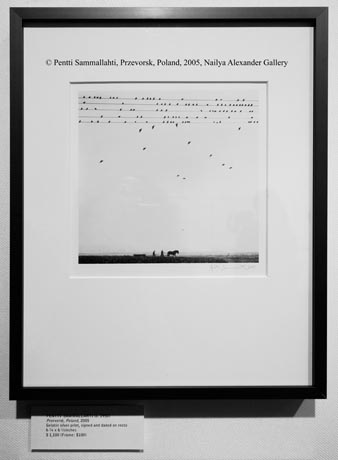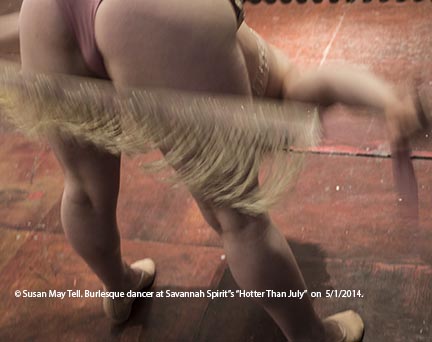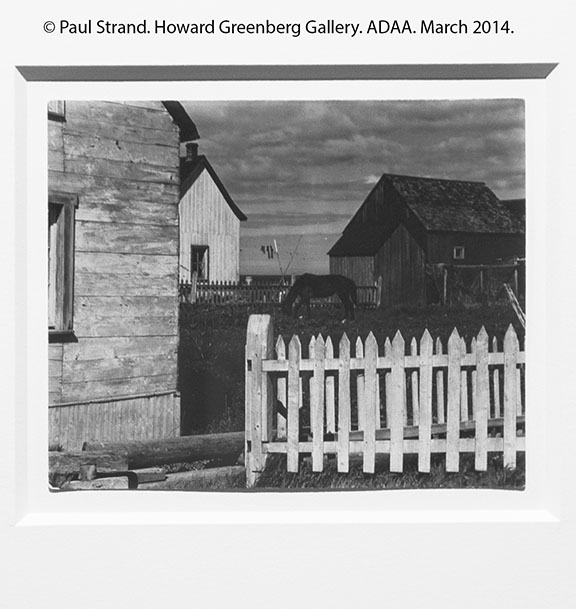|
|
|

|

|

|
Exhibitions I've seen in New York City with musings and commentary about photography-in-general as well as the specific exhibitions. These columns appeared in the online magazine of American Society of Media Photographers, New York Chapter (ASMPNY) and written during the ten years I was the Fine Art Chair of the 1,000 member chapter.
- March 2015
- June 2014
- March 2014
ASMP NY COLUMN: SEEN IN ART, JUNE 18, 2014
BY SUSAN MAY TELL, ASMP NY FINE ART CHAIR
As the Fine Art Chair of ASMP NY's 1,000-member chapter, welcome to the 2nd column on Art Happenings for "Sharpen," our new online magazine. This curated column, by necessity, touches upon only a very few of the many worthwhile fine art exhibitions and events in New York City; it includes commentary on things I've seen as well as recommendations for current and future happenings. This column will also appear on "Sharpen" just as soon as the magazine goes 'live' in the near future.
First, thanks to all who contacted me after reading the Inaugural Column, archived below. One sentence from that column seemed to resonate with many of you: One of the reasons we (ASMP NY and I), more than any other photographer organization, are committed to spending time covering Fine Art happenings is because I believe at the heart of every editorial & commercial photographer is a fine art photographer, which is what drew her/him to the field of photography in the first place.
SEEN
How often do you get to attend an exhibition of a foremost living photographer WITH the photographer present at the opening? In April I was blessed to attend two! Duane Michals and Lee Friedlander.

Duane Michals’ exhibition, "Empty New York”, opened at DC Moore Gallery in Chelsea. Not only was he there, but after spending time seeing the entire exhibition on my own, he personally guided me around it a second time. The exhibition consists of 30 black-and-white photographs taken and printed in 1964. The prints, gelatin silver, are small (4 3/4 x 6 7/8 inches to 8 x 10 inches)—a refreshing experience compared to the behemoth prints hanging in many galleries today. The size forces one to move close, very close, which creates viewing them an intimate, one on one, experience.
During a panel discussion in March at The Armory Show, Michals said he prefers photography books to exhibitions. That sentiment is shared by Lee Friedlander who has said “the book is more my medium than the wall.”
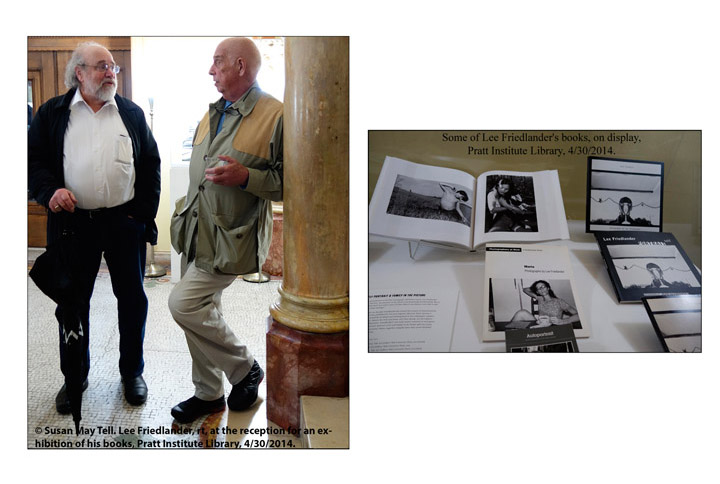
More than 40 of Lee Friedlander's books, published between 1969–2014, are exhibited at Pratt Institute’s Library. At its opening, Friedlander graciously signed the copy of his wonderful book "America By Car" which I brought from home.
Knowing how difficult it was to find places to pull the car over when photographing my 2012 Appalachia series, I was curious how he managed to to do it to perfection, over and over. He told me “Luck. I was lucky.” Hah! I find that hard to believe. “Lee Friedlander: The Printed Picture” was curated by Stephen Hilger, chair of Pratt's Photography Department and Peter Kayafas, director of Eakins Press Foundation.
Special thanks to April Renae and Ellen Wallenstein for the Friedlander heads-up!
AIPAD
The month of April also offered an embarrassment of riches because it included THE busiest and most exciting week in NYC for photography. Most every major gallery, museum curator and collector was in town for The Association of International Photography Art Dealers (AIPAD) and related events.
AIPAD - CONVERSATIONS / OVERHEARD
- A gallery owner (not telling you which one) said: "I'm having buyer's remorse. I saw a photograph so beautiful, so rare. Having anxiety. I can either get the photograph or buy a condominium for my daughter." Then he added: "Money always comes back. Art doesn't."
- At the M97 Gallery, Shanghai, China: A visitor to the booth told gallery director Steven Harris: "I like analogue. When I see people using it I want to run up and shake their hand."
AIPAD - GALLERIES
Since last year’s AIPAD, two major photographers passed away: Bill Eppridge (October 2013) and Saul Leiter (November 2013). I was struck by the similarity in the photographs chosen to represent them by their long-time galleries.
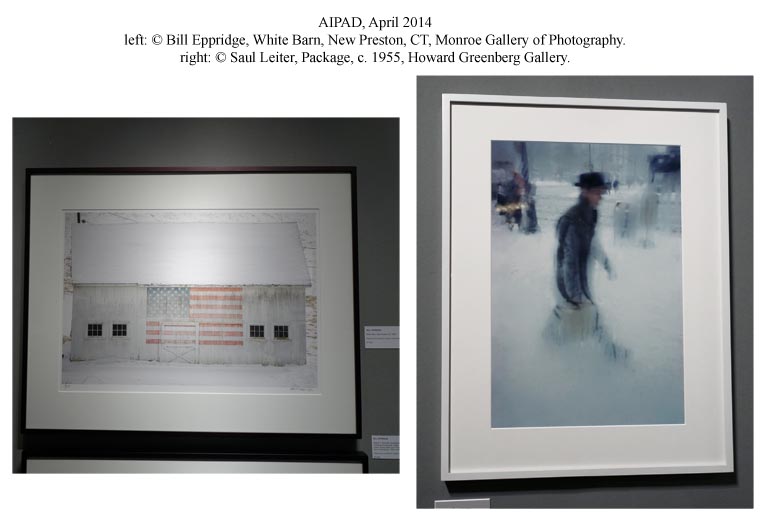
The Monroe Gallery of Photography from Santa Fe, New Mexico chose Bill Eppridge's photograph White Barn, New Preston, CT. Sid Monroe, also his friend, said that after 9/11 Eppridge noticed farmers in his Connecticut area painting American flags on their barns as a response to the attacks. Monroe said White Barn, taken in snow several years later of a faded flag, represents "the passing of time."
Saul Leiter's Package, c. 1955, chosen by the the Howard Greenberg Gallery, has a similar ephemeral quality. In it, a man is seen through the condensation of a window, somewhat blurry, rushing past, in snow.
The inspired choices by these galleries attest to the photographers' artistic presence as well as suggest their physical absence.
Although not an AIPAD event, that Sunday I was honored to attend the moving and sometimes humorous "Celebration of The Life and Art of Saul Leiter."
Attending AIPAD annually since 2009, one of the things I like best is re-visiting the non-NYC galleries which consistently show work which wows me, year after year. Those mentioned below are presented in no particular order.

Photographers as well as gallerists, the husband and wife team, Janet Russek and David Scheinbaum, are currently photographing the Lower East Side together, she with digital color and he with medium format, black-and-white, film. Prints by Aaron Siskind, Harry Callahan, Minor White and Elliott Porter were among those displayed in their booth. Ann Landi in the May issue of ARTnews reviewed “On View,” the gallery’s current exhibition and eloquently expressed what I’ve been feeling: "In an era when mural-size C-prints seem to be dominating the galleries, it’s a joy to revisit black-and-white photographs that were made during the last century, when a gelatin silver print of modest proportions could pack as much wallop as a Cindy Sherman psychodrama.”

André Kertész's photograph, Sécurité, (Boulevard de la Madeleine), Paris, 1927, tugged at my heart strings. Kertész is one of my all-time favorite photographers, and as familiar as I am with his work, seeing a print never fails to produce an "Aha! Moment." Also at the gallery, Paul Berlanga, its co-director, pointed out György Kepes' photograph Juliet's Shadow Caged and described it as the "best of abstraction with humanism, and is sexy."
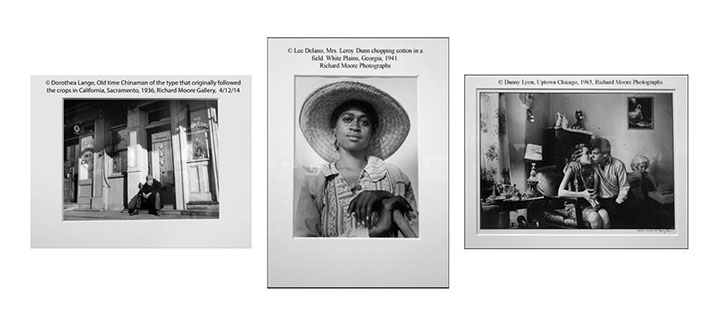
There are always a few photographs Richard Moore shows which take my breath away. Usually by Dorothea Lange. This year was no exception. Lange's Old time Chinaman of the type that originally followed the crops in California, Sacramento, 1936 captivated me: its directness, seeming simplicity and understated feeling. Commenting on Lee Delano's portrait, Mrs. Leroy Dunn chopping cotton in a field. White Plains, Georgia, 1941, Moore pointed out the low camera angle and how it reinforces Mrs. Dunn's dignity. On the business side of fine art photography, Moore reflected on how this wonderful photograph would have been snatched up had Lange's name, not Delano’s, been attached to it. Assisting in the gallery booth was Kathryn McElroy, who worked under Deborah Bell at Christie's, and enthusiastically spoke about Danny Lyon's work.

It was a surprise to notice that Louis Faurer's photograph, Family. Times Square, New York City. 1950, printed in 1980, was editioned since doing so had not been mentioned when I started exhibiting in the early 1980’s. Not in classes, workshops, discussions with the well-known or other just-emerging fine art photographers that I knew. This print was 17/25. Somehow a discussion with Martin Weinstein about this, segued into a discussion with him about Helen Gee and her book about The Limelight, the first gallery devoted exclusively to photography, which she founded in the 1950's, in Greenwich Village. Weinstein shared a great anecdote about Gee, who had been my mentor and friend.
Weinstein recalled that, eons ago, she and he were speakers at Columbia College in Chicago. Gee spoke first, chain-smoked the entire time, and was so funny that when it was his turn to speak he just announced to the audience "I'll answer any questions but I'm not going to talk." Weinstein added: "she was a tough lady.”
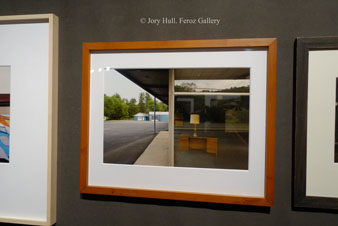
-Feroz Galerie, Bonn, Germany
As I was admiring Jory Hull's photograph, the gallery owner approached and explained his insistence that Hull show his work. He met Hull years ago, when they both had studios in the same Brooklyn building. When I asked if he, too, was a photographer he said "fourth generation.” A quick peek at his name tag, Julian Sander, explained everything; his great-grandfather was August Sander!

It was exciting, and somewhat surprising, to see a booth dedicated to Roy DeCarava, another of my all-time favorite photographers. Gallery owner Karen Jenkins-Johnson seemed equally excited to be showing his work at AIPAD. In the late 1970's, when DeCarava viewed my portfolio, there was one photograph he kept returning to--Man at Windows on the World, WTC. I offered him the 11x14” gelatin silver print but he refused and passionately said "never give your photographs away." Although I was not a student at Hunter College, he invited me to attend his class for the semester. Which I did. When, at the end of the semester, I offered to sell him the print for a penny, I was honored that he bought it.

Roy DeCarava's Dancers, 1956 is a perfect example of Vicki Goldberg's description of DeCarava's "distinctive range of middle tones, nearly eliminating black." During the semester I attended his class, he referred eloquently to a "velvet black"--"a black with air in it, that you can see into."
It's always fun to read the informative text that Michael Shapiro posts adjacent to the photographs in his booth. In 2010, when he displayed Robert Frank's City of London, 1951, in addition to his regular informational text, Shapiro posted photo copies of two letters, dated 1991, about that particular print. One letter was to Frank from Shapiro requesting information about the print--which he had acquired from Harry Lunn in 1991. The other letter was Frank's blunt response: "I will not comment on the print you have acquired from Lunn. but [sic] I will tell you that Lunn is a cheap cunning lying bastard."
-PDNB Gallery, Dallas, TX
Another treat at AIPAD is the chance occurance to be admiring work in a gallery's booth, turn around and find oneself face-to-face with the artist who took that work. Which is how I got to meet and speak with photographer Earlie Hudnall Jr.--who has been represented by PDNB since the 1990's.
AIPAD - ADDITIONAL HIGHLIGHTS
Marc Riboud, Antiquary Windows, Beijing China, 1965
Pentti Sammallahti, Przevorsk, Poland, 2005
Cig Harvey, The Roof Top, Dad's House, Self-Portrait, Flatts, Bermuda
AIPAD - PANEL DISCUSSIONS

1) THE DECIDERS: CURATING PHOTOGRAPHY
Moderated by Lyle Rexer, faculty member, School of Visual Arts, New York, curator; critic. Panelists: Johan Sjöström, Gothenburg Museum of Art, Sweden; Nissan Perez, Shpilman Institute for Photography, Tel Aviv; Digital Tech; Corey Keller, San Francisco Museum of Modern Art; and Jeff Rosenheim, The Metropolitan Museum of Art, New York.
The discussion was taped and will be available on the AIPAD website at a later date. Meanwhile, here is one quote from each panelist.
Nissan Perez: "The role of the museum is education, not the market. The market will follow."
Jeff Rosenheim: "The role of the museum is inspiration and context...to experience art without someone whispering in your ear."
Corey Keller: "Curators make decisions that others don't agree with."
Lyle Rexer: "I liked the Robert Frank exhibition at the Metropolitan Museum of Art because I saw how he thinks." (The installation showed the exhibition prints hung in the same sequence which Frank chose for the book "The Americans" and included contact sheets and outtakes, as well.)
Johan Sjöström: When the discussion turned to museums shying away from exhibiting Vivian Maier because she hadn't edited or printed her own work, Sjöström said "An exhibition of her work is scheduled next year in Sweden."
Before the discussion turned to Maier, Rosenheim and Keller spoke about a new exhibition of Garry Winogrand's work. Many of the photographs were from film developed after his death and not edited by him. The exhibition, which debuted at the San Francisco Museum of Modern Art, opens at the Metropolitan Museum later this month (June 2014).
2) PERSPECTIVES ON COLLECTING
Moderated by Loring Knoblauch, founder and publisher, Collector Daily (and ASMP NY Fine Art Portfolio Reviewer). Panelists: Fred and Laura Ruth Bidwell, Cleveland; Michael and Elizabeth Marcus, Boston; Artur Walther, New York.
This discussion was also taped and will be available on the AIPAD website at a later date. Some tidbits:
Loring Knoblauch expertly guided the discussion by asking each, in turn: "What you collect?" Why?" "How?" "Has your eye changed over the years?"
Michael Marcus: "Collecting is an addiction...that won't shorten your life."
Fred Bidwell: "We often buy from unrepresented artists, never as an investment."
Artur Walther: "If I collect someone, I collect them intently; I have hundreds of photographs by some photographers."
SEEN in the GALLERIES
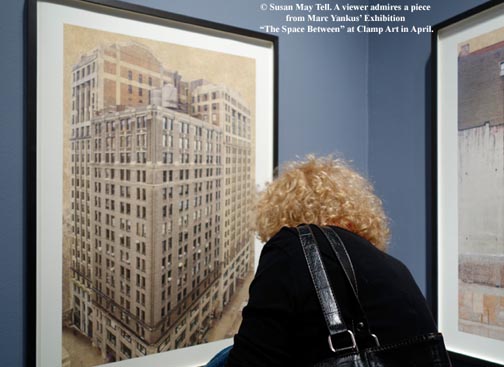
-The Space Between - Marc Yankus, ClampArt
Viewer after viewer approached the prints to examine them, hoping to get a better sense of how Yankus created their hyper-real quality. He said he's been working on this project, so far, for one and a half years.
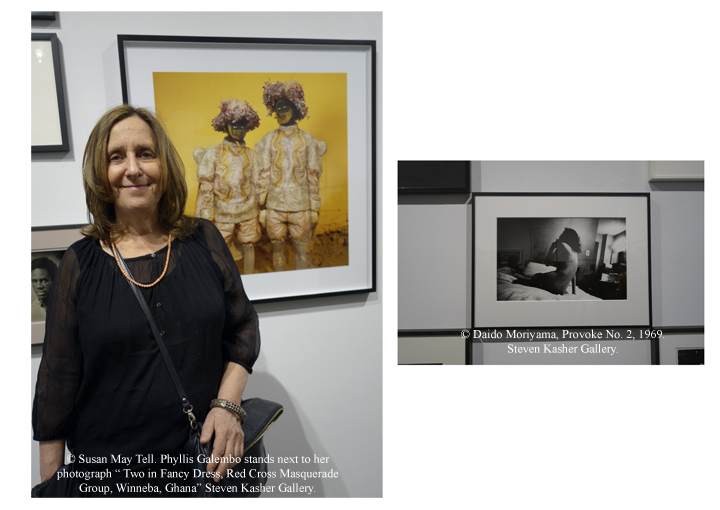
-Slaves of Mimesis: Nine Years on 23rd Street - Group Exhibition, Steven Kasher Gallery
I am always in awe of how well the Steven Kasher Gallery combines disparate photographs to create magnificent group exhibitions. It was a special pleasure to see Phyllis Galembo at the opening reception so I could congratulate her, in person, for being awarded a 2014 John Simon Guggenheim Fellowship in photography.

Found my passport (LOL) and went to Rafael Fuchs'* studio/gallery in Brooklyn with Pamela Jean Tinnen* and Zach Ranson for the opening reception of Up, Close and Personal, curated by photographer and collector Ruben Natal San-Miguel*. The exhibition included the work of thirty-two artists, many of whom were at the fun opening which also featured DJ callmeyo. Although I missed Jerry Saltz, seen at the fun, well-attended, event were Sheri Lynn Behr, David Carol*, John A. Bennette*, Savannah Spirit*, Norm Borden, Nancy Siesel, Pete Riesett, Raymond Adams, Jon Feinstein*, Lisa Levy and Michelle Cheikin. * indicates they have been reviewers at ASMP NY's Fine Art Portfolio Reviewers.
-Hotter than July: A Sexploration, curated by Savannah Spirit at NY Studio Gallery
Another fun event! This one with a burlesque show! Pictured above, one of the burleque dancers performing in Savannah Spirit's packed event. When the Huffington Post reviewed the exhibition, the article was accurately labeled "NSFW" (Not Safe For Work)! Also, got to hang out with Thomas Donley, Mark Kalan, and Pamela Jean Tinnen.
_______
ASMP NY COLUMN: SEEN IN ART, MARCH 28, 2014
Inaugural Column: March 28, 2014
back to top
As ASMP NY's Fine Art Chair I welcome this opportunity to write a monthly column about Art Happenings for ASMP NY's new online magazine.
There are hundreds, if not thousands, of fine art photography exhibitions, panel discussions, book signings, events, openings, and film screenings which occur in NYC every month. There is no way to include everything!! (That's when Bing and Google are your best friends.)
This curated column will, by necessity, touch upon only a very few of the many worthy events and will include commentary of things I've seen as well as current and future happenings.
One of the reasons we (ASMP NY and I), more than any other photographer organization, are committed to spending time covering Fine Art happenings is because I believe at the heart of every editorial & commercial photographer is a fine art photographer, which is what drew her/him to the field of photography in the first place. Even if you don't consider yourself a fine art photographer, knowing what is being exhibited and shown is an integral part of being a successful photographer.
SEEN
NYC was home to many (too many?) Art Fairs in early March! ASMP NY Board Member April Renae and I went to the The Armory Show where we met up with Fine Art Reviewer Pamela Jean Tinnen; Pamela had been recruited to be a tour guide for the show. We were treated to a wonderful discussion with the funny and charming Duane Michals as a panelist. We learned he loves books and doesn't like exhibitions (although he's had plenty.) He doesn't believe the "giant" photos he sees exhibited in galleries work in books. He spends his money on buying books—which, he said, explains his wearing 50-year old clothes. And, by the way, he still uses a rotary phone. The panel was moderated by Cay Sophie Rabinowitz, Founder and Publisher, OSMOS, the other panelists were Christophe Boutin, OneStar Press, Paris and Anna Moschovakis, Writer, Translator and Member of the Ugly Duckling Presse publishing collective. Photographer Tamara Rafkin, visiting from Belgium, who will be exhibiting at OSMOS, gave me this heads-up.
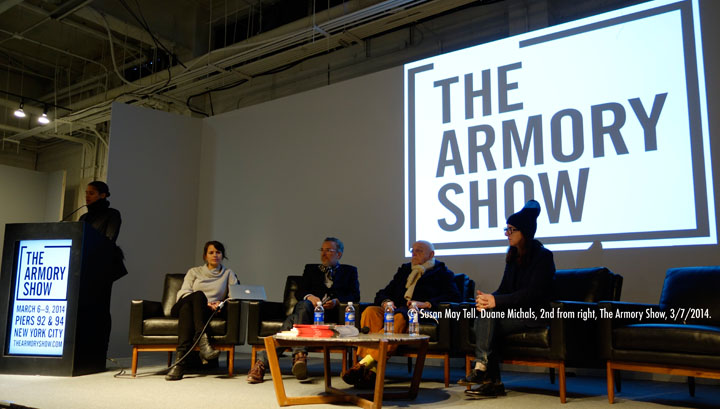
After leaving the panel, we navigated the show where most of the photographs seemed to be printed for people with bad eyesight, due to their huge size. Spontaneously and independently, April and I joked the photographs were larger than our apartments.
Although we didn't see the entire fair, we were rewarded with visiting Ani Molnar, the first Hungarian gallery to exhibit in the history of the fair, which presented a site specific work by Estonian photographer Dénes Farkas. Dénes, whose work was exhibited at the Estonian Pavilion at the 2013 Venice Biennale, said his thesis was on André Kertész, one of my all-time favorite photographers, which seemed more than a happy coincidence.
The following day I visited the Art Dealers Association of America (ADAA) Show at the New York Armory. Maybe because it was smaller and quieter, the galleries and art seemed more accessible and rewarding. Maybe it was just because the art was more rewarding.
One of the highlights was Arne Svenson’s "The Neighbors" at the Julie Saul Gallery. Svenson, as you might recall, was sued by some of his Tribeca neighbors for invasion of privacy. Judge Eileen A. Rakower dismissed the lawsuit because "An artist may create and sell a work of art that resembles an individual without his or her written consent.”
Other highlights were Irving Penn’s "Earthly Bodies" at Pace/MacGill Gallery and Robert Kinmont’s “My Favorite Dirt Roads” at Alexander and Bonin.

Last, but definitely not least, was feasting on several photographs at the Howard Greenberg Gallery. These included wonderful photographs by Walker Evans (printed in 1935), Paul Strand, and Edward Steichen as well as "Apartment Complex" by Edward Burtynsky. The Howard Greenberg Gallery also showed 4 sublime Saul Leiter’s at The Armory Show.
Non-photography art which, not for the first time, captivated me was AD Reinhardt’s black paintings at David Zwirner. I first saw this work when I was photographing at night and became excited to see work darker than what I was photographing. When is black truly black? When is it nuanced black? How can something so dark communicate emotion? I only have questions, not answers. Reinhardt is known for saying “Art is Art. Everything Else is Everything Else.”
Non-photography art, which I had never seen before, which absolutely mesmerized me was James Castle at Peter Freeman, Inc. Castle, as I learned, was born deaf, in Idaho, and self-taught. His work was described as having been made as “found paper and soot.” "Found paper” was whatever he found in the general store his parents owned — such as the back of an oatmeal or match box. “Soot" came from the stove, which he wet with his saliva. Freeman gave out a beautiful 16-page foldout with Castle’s images and an excellent essay written by Joseph Grigely.
Some of the worthwhile art fairs I didn’t get to were Pulse, Independent, Last Brucennial, Fountain (with work by ASMP NY Member Stephen Mallon) and SCOPE (with work by Member Barry Rosenthal). Put them on your schedule for next year.
The most gratifying event I attended was a lecture at the Metropolitan Museum of Art. The Members-Only lecture “Photography from the Museum’s Collection” was given by Jeff Rosenheim, the Met’s Curator in Charge, Department of Photographs. As images were projected, Jeff gave fascinating commentaries (anecdotes, back stories, significance) on each photographer and the work. In addition to Atget, Evans, Brassai, Stieglitz, Strand, Levitt, Bresson, Arbus, Polidori and other well-known luminaries, he discussed photographs he acquired for the museum and its blockbuster exhibition on Civil War photography. This included Sojourner Truth's portrait, prints of which she sold herself to raise funds for her many causes; this was the first time a photograph had ever been used for this purpose.
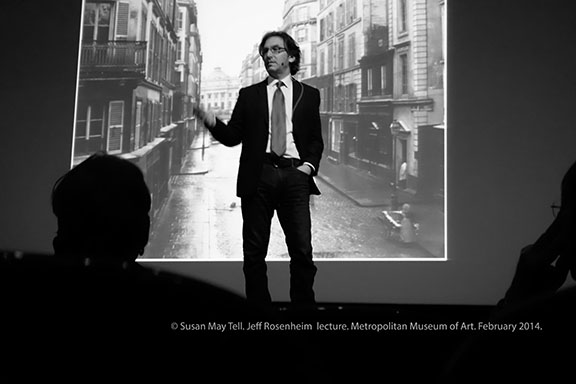
An exhibition of Garry Winogrand's photographs is scheduled to open in late June. Jeff, who studied with Garry, said his class was "the scariest" since Garry insisted the photographer was "responsible for every square inch of the picture."
Some of you may remember that in 2011, Jeff was on a panel, Curators and Dealers, with Howard Greenberg (Owner, Howard Greenberg Gallery) and Brian Wallis (Director of Exhibitions and Chief Curator, International Center of Photography), which I moderated for ASMPNY.
All content Copyrighted by © Susan May Tell
|
|

|

|
|

|

|
|
ALL PHOTOGRAPHS ON THIS SITE ARE © SUSAN MAY TELL. ALL RIGHTS RESERVED. NO REPRODUCTION OF ANY IMAGES ALLOWED WITHOUT WRITTEN AUTHORIZATION BY SUSAN MAY TELL.
|

|
|
|

